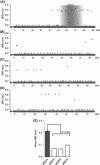A quantitative trait locus responsible for inducing B-cell lymphoblastic lymphoma is a hotspot for microsatellite instability
- PMID: 20353532
- PMCID: PMC11159001
- DOI: 10.1111/j.1349-7006.2009.01437.x
A quantitative trait locus responsible for inducing B-cell lymphoblastic lymphoma is a hotspot for microsatellite instability
Abstract
While the molecular mechanisms underlying microsatellite instability (MSI) have been exhaustively investigated, identifying the patterns of MSI distribution within diverse cancer genomes has remained an elusive issue. In the present study, we conducted genome-wide MSI screening in B-cell lymphoblastic lymphomas (B-LBL) which spontaneously develop in the SL/Kh strain of mice. Tumor samples harvested from 16 mice were investigated using a framework map consisting of 150 microsatellite markers spaced at increments of roughly 0.5-3.0 centimorgans, spanning the entirety of mouse chromosomes (mus musculus chromosomes [MMU]) 3-6. MMU3 contains a quantitative trait locus (QTL), Bomb1 (bone marrow pre-B1), known to induce an aberrant expansion of pre-B cells in bone marrow prior to the onset of B-LBL in SL/Kh mice. The remaining chromosomes were selected on the basis of those most closely resembling MMU3 in terms of total estimated length (maximum variance 10 Mb). MSI was confirmed at 2<or= markers in DNA derived from tumor tissues in 15 SL/Kh mice (93.7%), while healthy splenic DNA samples screened in parallel were consistently negative for MSI. The overall MSI incidence was significantly higher on MMU3 compared with MMU4-6 (P = 0.031). Additionally, by applying spatial point pattern analysis combined with a 1-D version of Ripley's K-function, we successfully demonstrated the predilection of MSI-susceptible loci to structure a massive cluster within the Bomb1 locus. Our study is the first to suggest that a QTL concomitantly serves as a hotspot for MSI-susceptible loci and sheds new light on somatic cancer genetics.
Figures



Similar articles
-
Diffuse large B-cell lymphoma of the stomach: assessment of microsatellite instability, allelic imbalance, and trisomy of chromosomes 3, 12, and 18.Diagn Mol Pathol. 2002 Jun;11(2):75-82. doi: 10.1097/00019606-200206000-00003. Diagn Mol Pathol. 2002. PMID: 12045710
-
Bone marrow pre-B-1 (Bomb1): a quantitative trait locus inducing bone marrow pre-B-cell expansion in lymphoma-prone SL/Kh mice.Cancer Res. 1999 Jun 1;59(11):2593-5. Cancer Res. 1999. PMID: 10363979
-
Bone marrow pre-B expansion by SL/Kh-Bomb1 locus: not sufficient for lymphomagenesis.Leuk Res. 2008 Feb;32(2):309-14. doi: 10.1016/j.leukres.2007.05.013. Epub 2007 Jul 6. Leuk Res. 2008. PMID: 17617450
-
Tumor-specific microsatellite instability: do distinct mechanisms underlie the MSI-L and EMAST phenotypes?Mutat Res. 2013 Mar-Apr;743-744:67-77. doi: 10.1016/j.mrfmmm.2012.11.003. Epub 2012 Dec 1. Mutat Res. 2013. PMID: 23206442 Free PMC article. Review.
-
Pre-B lymphomas in SL/Kh mice: a multifactorial disease model.Cancer Sci. 2003 Oct;94(10):847-50. doi: 10.1111/j.1349-7006.2003.tb01365.x. Cancer Sci. 2003. PMID: 14556656 Free PMC article. Review.
Cited by
-
Hotspots of MLV integration in the hematopoietic tumor genome.Oncogene. 2017 Mar 2;36(9):1169-1175. doi: 10.1038/onc.2016.285. Epub 2016 Nov 7. Oncogene. 2017. PMID: 27721401 Free PMC article. Review.
-
ZFP521 contributes to pre-B-cell lymphomagenesis through modulation of the pre-B-cell receptor signaling pathway.Oncogene. 2016 Jun 23;35(25):3227-38. doi: 10.1038/onc.2015.385. Epub 2015 Nov 2. Oncogene. 2016. PMID: 26522721
-
Genome instability and lymphoma.Zhong Nan Da Xue Xue Bao Yi Xue Ban. 2021 May 28;46(5):552-557. doi: 10.11817/j.issn.1672-7347.2021.190427. Zhong Nan Da Xue Xue Bao Yi Xue Ban. 2021. PMID: 34148893 Free PMC article. Chinese, English.
References
-
- Soslow RA, Baergen RN, Warnke RA. B‐Lineage lymphoblastic lymphoma is a clinicopathologic entity distinct from other histologically similar aggressive lymphomas with blastic morphology. Cancer 1999; 85: 2648–54. - PubMed
-
- Cheng A‐L, Su I‐J, Tien H‐F, Wang C‐C, Chen Y‐C, Wang C‐H. Characteristic clinicopathologic features of adult B‐cell lymphoblastic lymphoma with special emphasis on differential diagnosis with an atypical form probably of blastic lymphocytic lymphoma of intermediate differentiation origin. Cancer 1994; 73: 706–10. - PubMed
-
- Sander CA, Jaffe ES, Gebhardt FC, Yano T, Medeiros LJ. Mediastinal lymphoblastic lymphoma with an immature B‐cell immunophenotype. Am J Surg Pathol 1992; 16: 300–5. - PubMed
-
- Link MP, Roper M, Dorfman RF, Crist WM, Cooper MD, Levy R. Cutaneous lymphoblastic lymphoma with pre‐B markers. Blood 1983; 61: 838–41. - PubMed
-
- Pattengale PK, Frith CH. Immunomorphologic classification of spontaneous lymphoid cell neoplasms occurring in female BALB/c mice. J Natl Cancer Inst 1983; 70: 169–79. - PubMed
Publication types
MeSH terms
LinkOut - more resources
Full Text Sources
Miscellaneous

